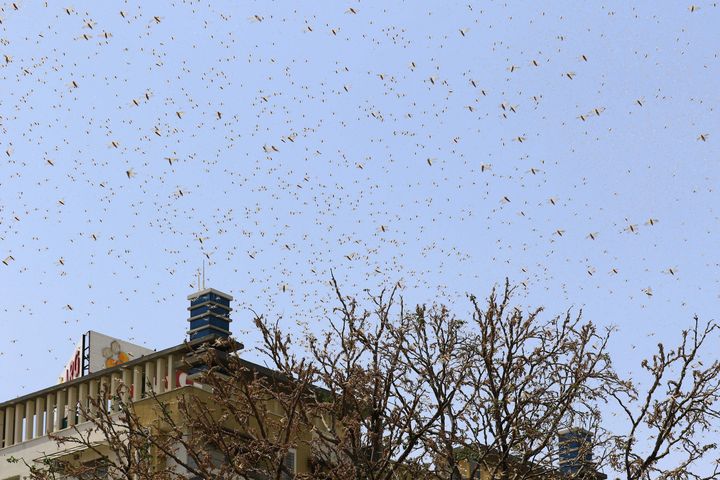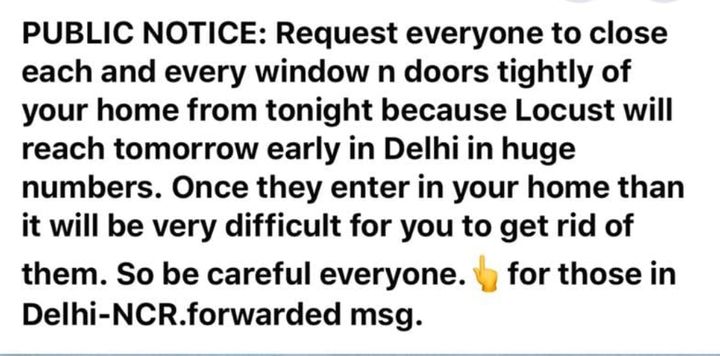
On Thursday evening, soon after the Delhi government issued an advisory with measures to prevent a “probable attack” of locusts, forwarded messages began doing the rounds on WhatsApp and social media, warning “those in Delhi-NCR” to shut their doors and windows tightly.
While Friday morning passed without incident, the message is still doing the rounds.

However, an official in the Locust Warning Organisation (LWO) told HuffPost India on condition of anonymity that locusts are NOT headed towards Delhi for now.
“There is very little chance that the swarms will come to Delhi. Locusts move according to wind direction and winds are not moving towards Delhi for now,” this person said.
They, however, cautioned that while the possibility is low, this may change if there’s a change in wind direction.
The locusts, which have left farmers on edge, entered India through Rajasthan on 11 April. The Union agriculture ministry said in a statement that there are some active swarms of immature locusts in some districts of Rajasthan, Uttar Pradesh, Maharashtra and Madhya Pradesh.
KL Gurjar, the deputy director of LWO, told The Indian Express on Thursday that the wind has to blow from west to east for the locusts to move towards Delhi from Rajasthan.
“But at present, the wind direction over Delhi is from the east. The population of locusts in Madhya Pradesh is not very high and, therefore, they won’t be able travel to Delhi. Efforts are also underway to control them there,” he told The Indian Express.
Gurjar did not respond to HuffPost India’s attempts to contact him.
The Delhi government’s advisory on Thursday had suggested three preventive measures to control locust attack in the national capital. The steps included organising awareness programme for general public and farmers, spraying of insecticides and pesticides as per need and allowing the insects to rest, “especially during night”.
Delhi Minister Gopal Rai said in a tweet that the government has issued an advisory informing people about insecticides and pesticides which can be sprayed on standing crops, vegetation, gardens and orchards to guard them from locusts.
Delhi’s forest department, according to PTI, is considering covering the saplings in its nurseries with polythene to protect them against locust attack.
“It is not possible to cover the trees. We will at least cover the saplings in the nurseries,” said Principal Chief Conservator of Forests Ishwar Singh.
“Covering plants with polythene can also be counter-productive during this heat. So, we will do this only when we know for sure that the swarm of locusts is headed towards Delhi,” the official was quoted as saying by PTI.
Singh said in a city like Delhi, spraying of chemicals can be detrimental for environment.
“If we spray the vegetation, trees and plants with chemical in anticipation of a locust attack, we should also consider how dangerous it will be for the environment,” he said.
The Food and Agriculture organisation, in its 27 May update, said that several successive waves of invasions can be expected until July in Rajasthan with eastward surges across northern India as far as Bihar and Odisha, followed by westward movements and a return to Rajasthan through the changing winds associated with the monsoon. The organisation said that the swarms are less likely to reach south India.
The unnamed LWO official cited above also said that they have received several calls from Mumbai since Thursday.
What happened in Mumbai?
There was panic in Mumbai on Thursday after some videos of locusts went viral on social media, according to reports.
Messages on WhatsApp groups and tweets, Livemint said, claimed locusts had been spotted in all parts of the city: Juhu, Goregaon, Tardeo, Bandra, Vikhroli and Malabar Hill.
Maharashtra state disaster management officials later clarified that no locust swarm was spotted in Mumbai. “The viral images and videos have been wrongly attributed as being from Mumbai,” an official told PTI.
Gurjar also told Hindustan Times that the invasion is restricted to parts of eastern Maharashtra, with districts in Vidarbha affected. “No such warning has been given for the Konkan region, including Mumbai, as the wind direction will not allow their movement to the coastal city from Gujarat,” he added.
While locusts do not harm humans or animals, they can cause significant damage to crops. The FAO says that a one square km swarm contains about 40 million locusts, which can eat the same amount of food in one day as about 35,000 people.
(With PTI inputs)
For the latest news and more, follow HuffPost India on Twitter, Facebook, and subscribe to our newsletter.